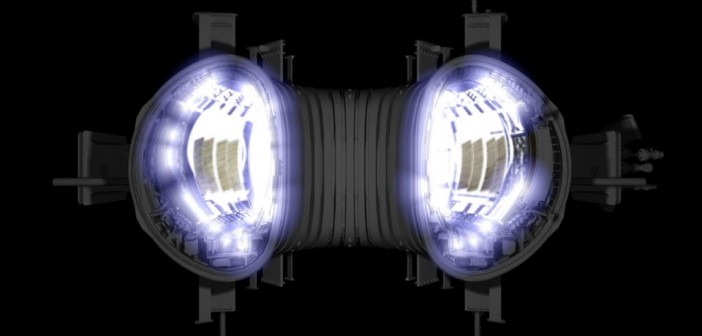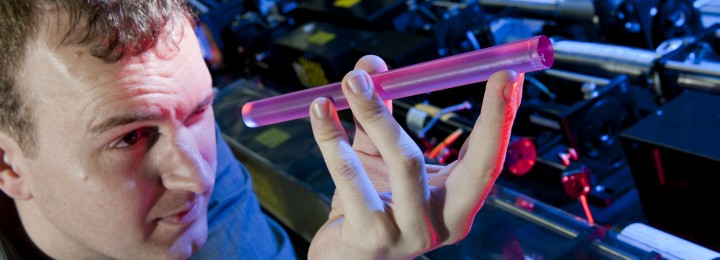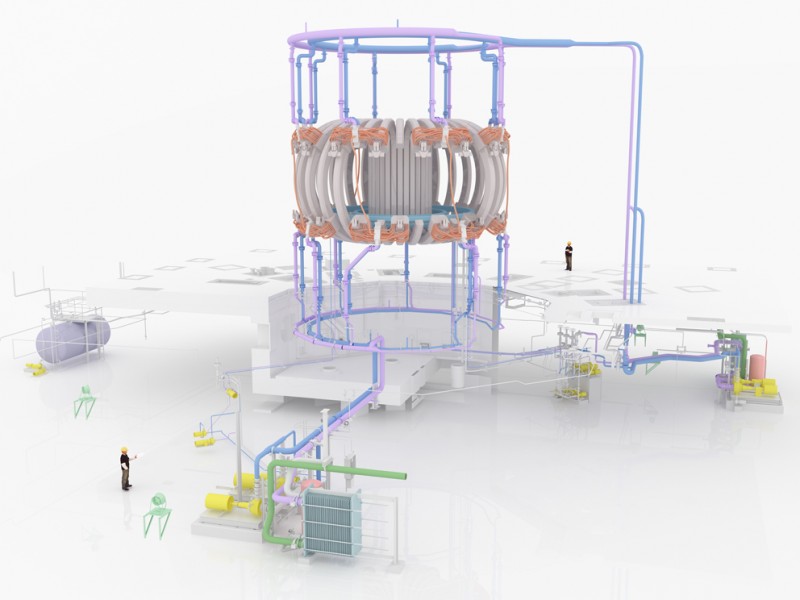ITER: ‘International Race for Fusion Energy Project’
On first look, the Culham Centre for Fusion Energy (CCFE) might just look like a lab, but the work happening inside will change the future of humanity forever. Its aim? To create energy, efficient energy that will never run out. Energy that will power our homes and drive our cars cheaply. It will save humanity…that is, if humans don’t spoil it first.
Science Editor Vasily Koledov visits the site and learns about the inner workings of the international fusion research project ITER: a project wrestling with budget constraints, global politics and even defence ministries looking for information on nuclear bombs. Thankfully, a team of dedicated scientists are working against all that to rescue the future of the planet. Tony Donne, head of Eurofusion at CCFE, tells Vasily about how fusion can change the world and what still needs to be done for it to do so.
VK: Tony, thank you for taking your time to meet. Please could you explain the situation at the moment?
TD: Right now we are at CCFE which operates the JET Fusion reactor which is the Largest working fusion reactor in the world. The reactor is close to hitting break even (make as much fusion energy output as energy input to start the reaction). The research here is focused on studying hot plasma inside the reactor which heats up to 100-150 million degrees Celsius.
Alongside this, we are helping build the ITER reactor in France which is currently one of the largest scientific projects worldwide at a cost of around 16bn EUR. This will be a 500MW reactor, capable of delivering 10x more power than is currently being put in.
ITER is an international project, being built in France with participation from Russia, India, China, the U.S. and many other countries. Brazil is also planning to join.
In parallel we are preparing to start work on DEMO which will be a follow on project from ITER and will be a fully working 2GW plant ready to be plugged in to the grid.
VK: What is the status of ITER – I know the project has been plagued by delays and cost over runs?
TD: ITER has had its share of problems. Personally, I think it has become too political (by politicians, not scientists). Selection of manufacturing is based on regional allocation rather than actual competency at the manufacturing. All the parties involved want to deliver finished products. Everyone wants to make superconducting coils, vacuum vessel cooling systems in particular.
So you end up with five factories built to make materials around the world whereas it could all have been done with one. Also all parties “deliver in kind” (i.e. deliver finished products) so the actual central team running the project has no money. The central team sets its requirements and sends to parties. Parties come back saying they do not have the budget and so things take far longer than they should. Having a decentralised model has led to ITER suffering a lot from a cost and time perspective. Current estimates are that is should be online by 2024-25.
So you end up with five factories built to make materials around the world whereas it could all have been done with one. If budgeted and executed more sensibly, ITER could have been built for half the price.
If budgeted and executed more sensibly, ITER could have been built for half the price. This has impact on work going on at DEMO as it will be too early to start work on this full speed until ITER is complete and we can get data from it.
VK: What about competition from the U.S., including the National Ignition Facility (NIF)? I also heard of some developments in the tokomak field by Lockheed Martin and other private corporations?
TD: NIF (the principal U.S. based fusion project which unlike the tokomak design in JET and ITER is aimed at starting a reaction by firing lasers at a helium particle) are far behind magnetic fusion. They have not reached ignition, they’ve just managed to obtain net yields and alpha particles. But what they did not calculate is that they have 196 lasers that are 200m long [which they need to fire up to start the ignition]and so they miscalculated energy requirement by a factor of 10,000. They also are only able to do the ignition once per day and as such, have a very long way to go.
I believe inertia fusion has a long way to go [before commercialisation]and is mainly driven by military interest. This is because since there is a moratorium on underground nuclear testing, this is an ideal way to make a miniature hydrogen bomb so you can do tests in lab and still get data. Budget into NIF is over two thirds from Department of Defence.
Lockheed Martins technology is “nonsense” – their patent application cannot work. Concept was already proposed in 1960s.
There is a moratorium on underground nuclear testing, this is an ideal way to make a miniature hydrogen bomb so you can do tests in lab and still get data
Companies like General Fusion in Vancouver want a reactor by 2020. They’re doing good work but going slower than expected.
VK: But is there a large-scale fusion program in the U.S.?
TD: In the U.S. there are 3 major tokomaks. But no umbrella organisation like Eurofusion. This is because in the U.S. they tend to only have a 10 year strategy so difficult to plan these long term projects. They focus a lot on research but not to actually build a new plant.
At a meeting in Washington fusion leaders – Russian, Europeans Chinese and Koreans – have a roadmap but the U.S. does not. One of the problems of the US is that they have a lot of fossil fuels and so fusion is not an issue. Politicians are just not putting a lot of money into this.
U.S are the least reliable partner for ITER. In 1999 they jumped out of consortium thinking design was too complicated. Japan, Russian and India continued as well as China. Then they came back.
The United States are the least reliable partner of ITER. In 1999 they jumped out of consortium thinking design was too complicated. Japan, Russian and India continued as well as China. Then they came back. Chinese are really pushing fusion due to pollution factors. In China every week they fire a new coal plant.
Chinese are really pushing fusion due to pollution factors. In China, every week they fire a new coal plant. And when you open one you operate for 30 years so things will not get much better. The level of pollutants in the air in Japan coming from China, are very high on many days (high the density of particulates in atmosphere) and so people are suffering. Korea has it even worse as it is between the two.
China actually has their own tokomak program, a large superconducting tokamak that is smaller than JET but similar to Germany. The Chinese do very good research.
VK: I understand there are several fuels that can go into a fusion reactor – which are the most efficient?
TD: There are 3 types of fuel we can use: Deuterium–Tritium , Deuterium–Helium 3 and Deuterium–Deuterium.
Deuterium–Tritium has the highest reaction possibility so it needs the lowest temperatures for combustion but presents two challenges. Firstly, tritium is radioactive (half life 12.5 – after 100 years all tritium is gone – which is why there is so little on earth). The neutron hits the wall of the reactor and energy of neutron generates heat and makes tritium from lithium. The problem is that it activates the wall of the machine, so this means at the end of lifetime the wall of the reactor is [radio]active. In a fusion reactor, the advantage over fission is that we can choose fuel.
Deuterium –Helium 3 would be good as Helium is advantageous (its neutronless). The fusion product is helium 4 plus a proton which essentially means no radiation at all. The challenge is Helium 3 is difficult to obtain
Deuterium – Deuterium – would produce a strong reaction but needs an internal combustion temperature that is nearly 5x higher than Deuterium –Tritium (so around 500 million celsius) which is difficult with current materials.
What is fascinating is that to run a reactor, you need about 500kg of fuel per 2GW reactor per year (deuterium and tritium combined) which is very little. To start a reactor you need about 10-20kg. You can actually take the fuel for the whole reactor, fit it into your car and drive as it’s not radioactive.
There is no problem with fuel supply as in every litre of water there’s 32mg of deuterium. Lithium is also rare but we can actually recycle old car batteries and use it as fuel.
What is interesting about the reactor design, is when we put a lithium over the reactor, when the neutron hits the lithium it splits into tritium and helium 4. As a result the reactor makes its own fuel. Helium 4 is also very valuable by product.
There is no problem with fuel supply as in every litre of water there’s 32mg of deuterium. Lithium is also rare but we can actually recycle old car batteries and use it as fuel. To clarify: the fuel cycle is not in itself fully regenerative meaning Deuterium and Lithium still have to be injected into the reactor periodically.
Confused? To understand the nuclear fusion process, see our fusion demystified article.
VK: What are the costs of setting up a fusion reactor?
TD: Initially the fusion reactor, due to the complicated production processes, will be more expensive to set up than a conventional nuclear reactor, but then fuel is free.
What is interesting is that these power plants do not take a lot of space. The ITER reactor will be 30 meters in diameter (only 2x larger at 10x the power of JET).
Nuclear power stations have a much larger dead area around the site where you cannot build. In this scenario, the very worst thing that can happen is tritium in gas form leaks out, but there will be only a few grams in the atmosphere (due to the small sizes of fuel needed for reaction to take place). So by the time it gets beyond the site area its completely diffused and non-lethal.
VK: What are the key challenges for fusion projects?
TD: Mainly politics and funding. The global fusion research budget is £3bn. In comparison, solar is £100bn and wind is £500bn. In addition, solar and wind have much smaller units.
If the industry jumps on fusion and starts funding projects, it will be easier.
There are other scientific hurdles – most important is heat exhaust. At the moment heat exhaust are 10MW/sqm. This is what you have on surface of the sun, so you need to create materials that can lie on the surface of the sun for many years. The big advantage is we can go with cooling. Currently we have materials that can do 20MW/sqm but for DEMO we might need more.
VK: What is the status of private funding
Larger energy companies have a shorter energy strategy than one that would put fusion onto their roadmap.
General Fusion is a private company that’s got $30m from Amazon CEO Jeff Bezos and another $20 from other investors. Private investment could speed things up. Fusion dynamics do a hybrid of inertia fusion and magnetic fusion. They start with plasma like in ITER, compress it, then again, to get more density and efficiency. What is cool is that they are making it in a plasma in a tank surrounded by TNT.
If you like this article you may be interested in “China Reduces Carbon Emissions the Size of the UK’s in 4 Months”.








